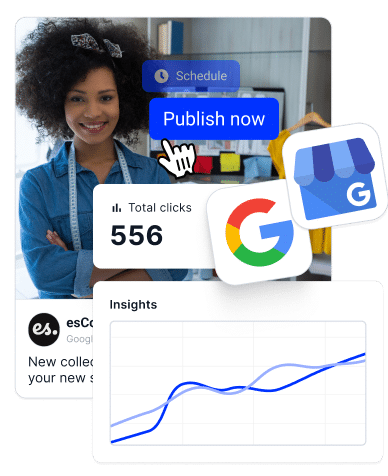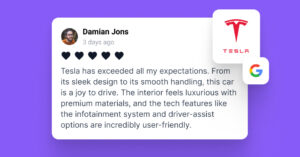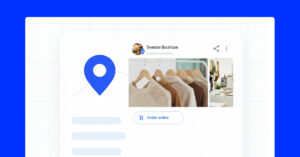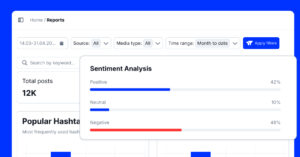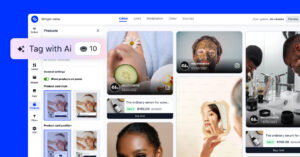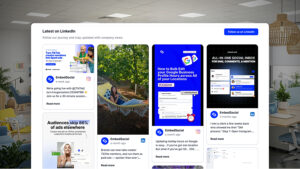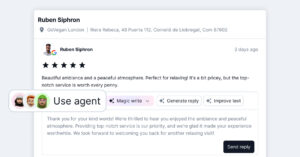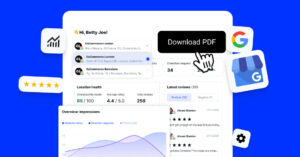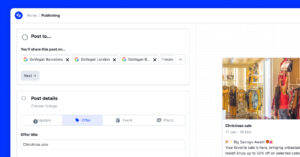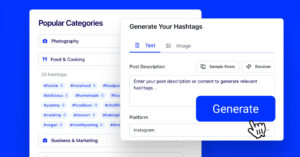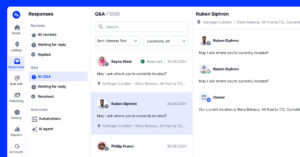Brands and businesses nowadays know that user-generated content (UGC) is a powerful tool that can drive engagement, build trust, and elevate your brand.
As everyone starts relying on authentic and relatable content from their customers to bring down costs and reach an audience, effective UGC management becomes essential. Don’t believe me? UGC in email marketing drives 78% more click-throughs. And that’s only one UGC stat!
So whether you’re collecting photos from social media, encouraging customers to share reviews, or repurposing content for marketing campaigns, having a solid UGC management process in place is crucial, as it helps streamline your content strategy.
What is UGC management?
Definition: User-generated content (UGC) management refers to the process of collecting, organizing, and utilizing content created by consumers, such as photos, videos, reviews, and social media posts. Instead of relying solely on branded content, businesses can harness the authenticity and engagement of UGC to enhance their marketing initiatives.
For businesses, UGC is invaluable as it can build trust, increase brand awareness, and provide social proof, which drives higher engagement and conversions.
By effectively managing UGC, businesses streamline their UGC marketing strategies, showcase genuine customer experiences, and maintain control over their narrative.
Below, I walk you through the entire UGC management process, from collection to analysis, providing actionable steps to help you harness your full UGC potential:
- UGC collection
- UGC incentivization
- UGC rights management
- UGC assets management
- UGC moderation
- UGC reusal
- UGC analytics
Ready to turn your customers into content creators? Let’s dive in!
How to collect UGC?
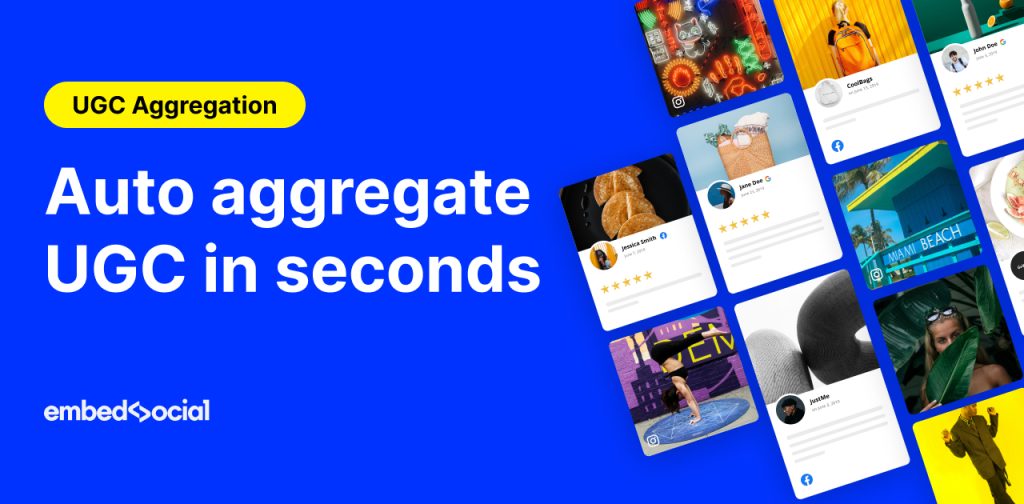
When collecting UGC, look into social media networks where your audience is engaging with your brands, such as social media, review platforms, blogs, and forums, or even your customer success team, as they have access to interviews and case studies.
UGC platforms like EmbedSococial can help collect all this user-generated content in seconds from all of the following (and other) sources:
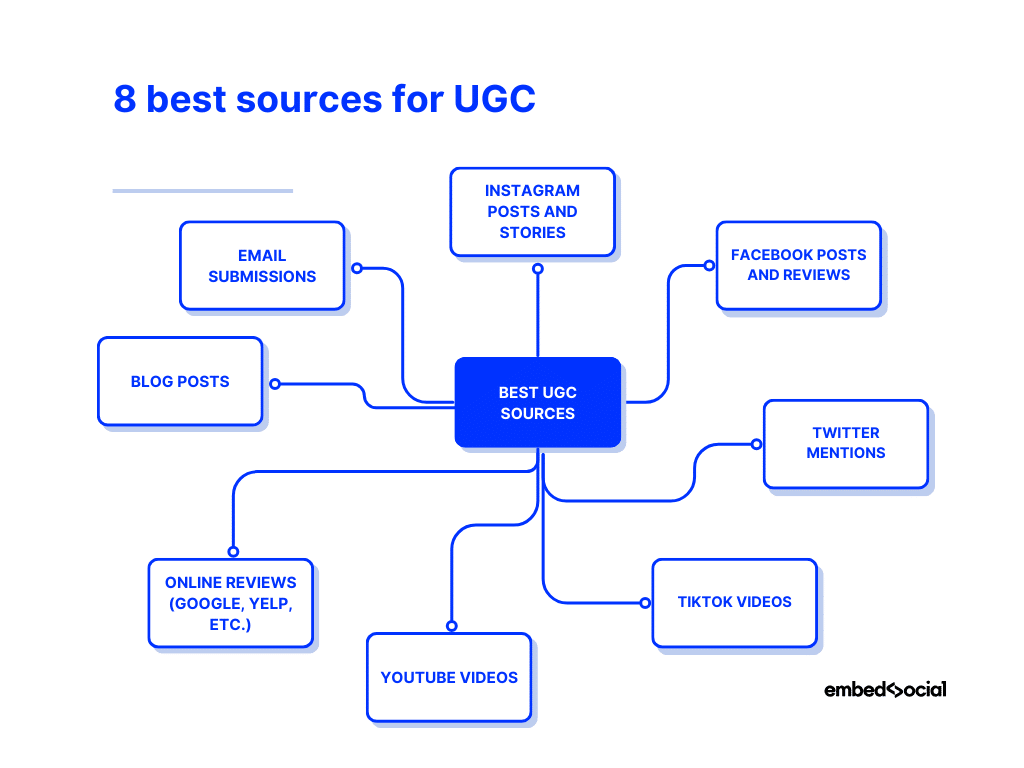
- Instagram posts and stories—track branded hashtags, monitor tagged photos and videos, and request content directly from users via DMs or comments;
- Facebook posts and reviews—use Facebook’s search feature to find mentions of your brand, set up alerts for page tags, and check for reviews;
- Twitter mentions—set up Twitter alerts for brand mentions, hashtags, and retweets, and use tools like Hootsuite or Sprout Social to track relevant conversations;
- TikTok videos—track branded hashtags and challenges, and search for mentions of your brand in the TikTok search bar to gather user-generated content;
- YouTube videos—search for videos mentioning your brand or product, subscribe to relevant channels, and use a keyword alert system to discover new videos;
- Online reviews (Google, Yelp, etc.)—integrate tools like EmbedSocial or Trustpilot to automatically get reviews from platforms and your Google Business Profile;
- Blog posts—set up Google Alerts or use tools like BuzzSumo to find blog posts mentioning your brand, then reach out to the authors for permission to share;
- Email submissions—encourage customers to send photos, testimonials, or experiences through email campaigns and forms embedded on your website.
By combining these sources with effective tracking and UGC collection strategies, you get a wealth of valuable UGC to enhance your marketing strategies.
That way, you can effortlessly manage and repurpose relevant UGC examples across various channels, driving engagement and building trust with your audience.
How to incentivize users to create UGC?
Encouraging your audience to create user-generated content requires offering them something valuable in return, such as tangible rewards, brand recognition, and exclusive access. The key is to align the incentive with your audience’s interests and preferences.
One effective method is running contests or giveaways. For example, offering a prize in exchange for users sharing photos or videos of themselves using your product is a simple but powerful way to get more UGC.
Discounts and loyalty points also work well, especially for e-commerce brands. You can offer a discount on the next purchase to those who share their UGC.
Additionally, featuring user content on your brand’s social media pages or website can be a strong motivator. People love recognition, and giving them a platform to showcase their creativity can encourage more participation.
Remember: the more personalized and relevant the incentive, the more likely users will be motivated to create and share UGC.
How to obtain UGC rights before posting?
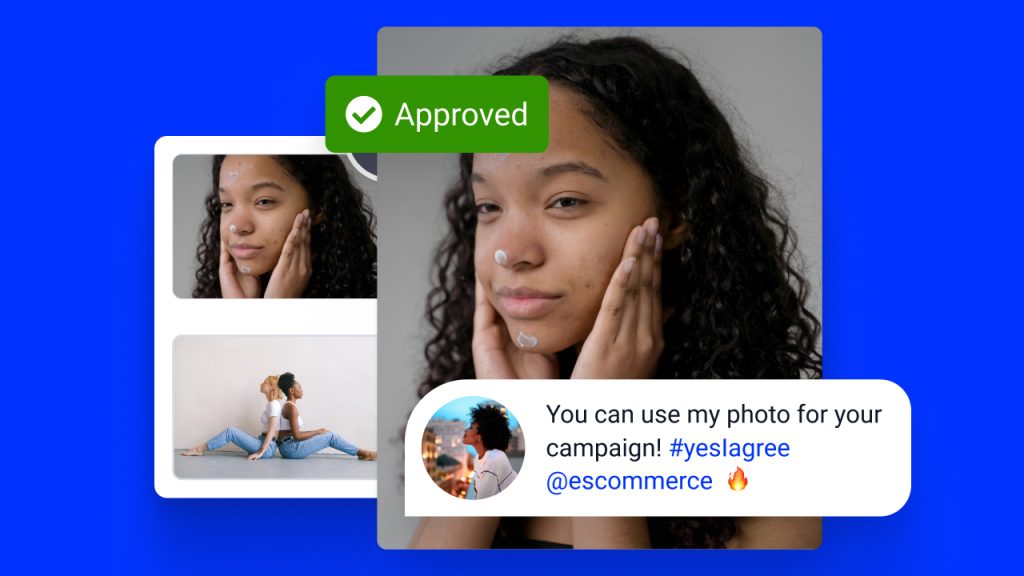
Obtaining the rights to use UGC from your customers or other users is a critical step in the UGC management process, as failing to get the necessary permissions can lead to legal issues, so it’s essential to follow proper procedures.
The best way to conduct your UGC rights management is by clearly communicating with the UGC creators. You should always ask for permission via DMs, email, or comments, ensuring they understand how and where their content will be used.
Legal considerations involve respecting intellectual property laws and ensuring that you have explicit consent from the creator. Plus, you should always keep records of the permissions you receive, especially when you are using the content commercially.
You can do one of two things to get UGC rights:
- Use legal templates for content releases and contracts—these documents outline the terms of use and safeguard both your brand and the creator, or
- Subscribe to a tool with a UGC rights request feature—these tools simplify the rights management process by automating permission requests, tracking the request status, and storing all consent agreements in one place.
Check out our UGC Rights Management blog post to learn more about obtaining the rights to someone else’s user-generated content. Plus, get the templates and tools needed to do that.
It covers everything from legal obligations to practical steps for acquiring and managing usage rights, helping you avoid pitfalls while maximizing the UGC value.
How to manage, store, and search UGC assets?
Managing UGC effectively requires a well-organized system to store and retrieve content, and the best approach is to centralize all UGC in one platform.
That way you can categorize, tag, and sort content based on your needs, which helps with staying organized and makes it easier to locate specific UGC when you need it for marketing campaigns, social media platforms, or other content strategies.
For efficient UGC storage solutions, consider using various cloud-based storage platforms, or even better, a complete UGC platform that collects, stores, and displays UGC like EmbedSocial, which helps you do all of the following quickly and easily:
- Seamless integration with all major social media channels—you can effortlessly gather posts, photos, UGC videos, reviews, comments, and more;
- Dashboard for social media mentions and user feedback—you can monitor, moderate, and prioritize all the UGC you collect from a single place;
- Embed interactive customer-centric widgets—choose from various pre-built templates for embedding reviews, Instagram stories, hashtags, and feeds, TikTok videos, forms, or Google reviews widgets with videos and photos, and more;
Once you connect your social accounts and add your UGC sources, EmbedSocial will obtain all the content from your social media, which you can use at any time.
Moreover, the platform will automatically pull in fresh content from your sources and organize it by date, platform, user tags, keywords, and more.
How to use AI to tag and organize posts automatically?
To ensure easy retrieval of your content, implement a consistent naming and tagging system. For example, tag UGC by product type, location, or specific campaigns.
This way, when you’re ready to reuse your content, you can quickly filter and search through the assets based on your needs, saving valuable time and resources.
However, you can also avoid this manual process of tagging every single post by using EmbedSocial’s AI enrichment feature, which automatically assigns tags and categories to all the UGC posts you collect. Using this feature only includes a few steps:
Step 1: Access the ‘Monitor’ section
After connecting all your social media sources in EmbedSocial, head over to the ‘Monitor’ section (from the left ribbon menu):
Step 2: Select the posts you want to categorize
Then, you simply have to select all the posts you want to enrich via our AI tool.
The ‘Bulk options’ dropdown menu will appear once you start doing so, and it will also allow you to ‘Tag the last 10 posts’ so you save on time and effort:
You can either tick each relevant post and click ‘Tag with AI’ or tap ‘Organize rows’ at the top to automatically enrich the last 10 posts you’ve collected:
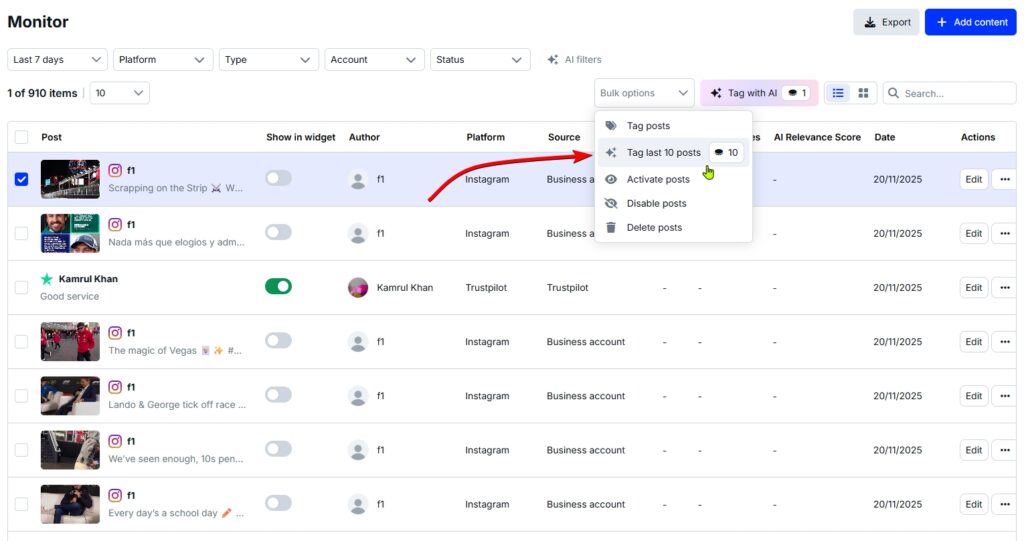
Note: You will spend 1 AI credit for 1 post. Therefore, if you enrich 10 posts automatically, you will use up 10 of your AI credits. So, check your credits before using the feature.
Step 3: Run the AI tool to automatically assign tags and categories
Once you’re done, you will get something like the following list, which includes up to 5 tags for each post and one of the following categories:
- Positive Feedback
- Complaint
- Brand Praise
- Potential Lead
- Promotional
- Noise
- Question
- Other
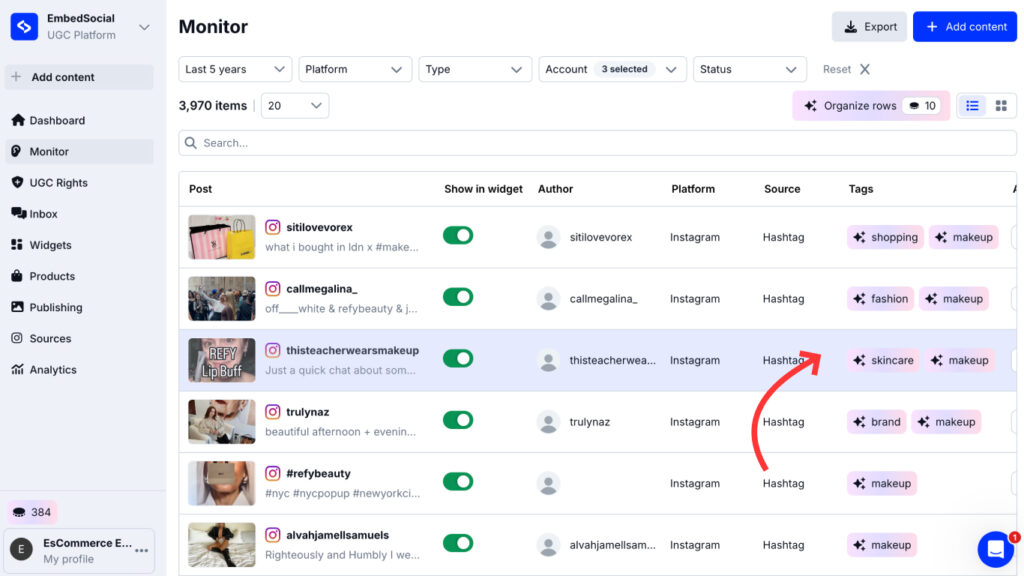
We’re also planning to add additional columns in the future, such as sentiment, summary, and recommended action.
Note: Needless to say, you can complete the above process only after creating your EmbedSocial account and connecting all your social media sources.
How to moderate the posts in your UGC widgets?
You have complete control over your UGC via the widget editor under the ‘Moderation’ tab:
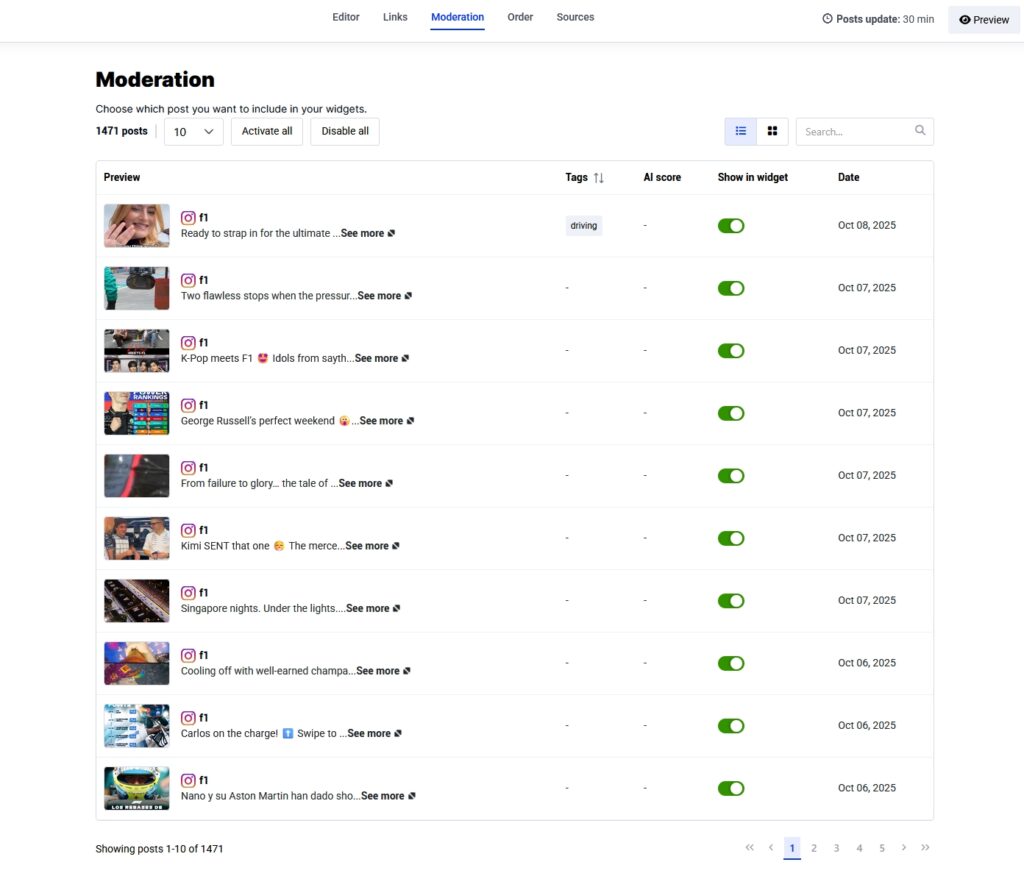
As you can see, you can toggle on and off specific posts so you can curate your fed.
That said, we also offer a better, AI-powered way of moderating all your posts automatically.
How to use AI scoring and moderation of your UGC?
You can initiate the process via the ‘Filters’ tab in your source page right after connecting it:
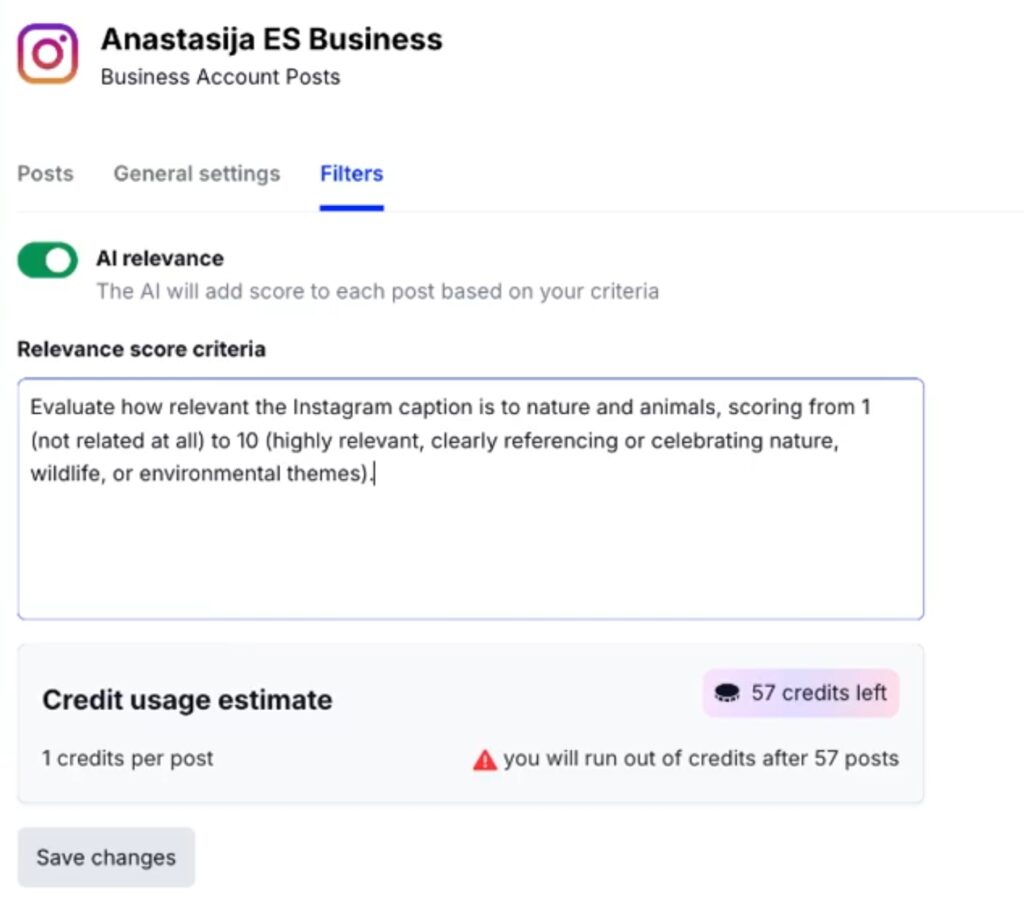
Once you set up your filters, our platform will start adding new posts to your widget based on them, provided they meet a pre-set relevance score.
In the following example, I’ve set up a minimum relevance filter of 76%, meaning, only posts tagged with a score equal to or higher than that will show up in my widget.
As you can see, at the moment, only one post meets that criteria:
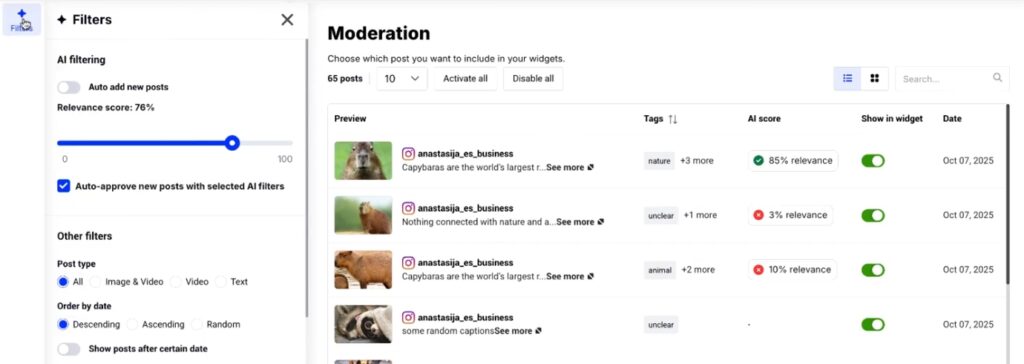
How to reuse UGC for marketing and sales via UGC widgets?
Repurposing influencer-generated and user-generated content across different marketing channels is one of the best ways to maximize its value.
For instance, UGC can be transformed into powerful marketing assets, whether for social media posts, email campaigns, product pages, or even ads. That said, you must maintain authenticity when aligning your content with your goals.
One best practice is to embed the UGC on your website, particularly on product pages, where potential buyers can see real customer photos and feedback. Social proof like this builds trust and can significantly improve conversions down the line.
Additionally, UGC can be repurposed for paid ads, as authentic testimonials and photos from customers often perform better than traditional branded content.
Lastly, you can embed your UGC into your email marketing—by featuring customer stories or photos in your emails and newsletters, you drive engagement and clicks.
Here are a couple of UGC examples of repurposing UGC with the help of EmbedSocial:
ASUS – #DesignYouCanFeel
This tech giant decided to launch a UGC-fueled campaign to promote their latest ASUS Zenbook lineup, as they rightly believe that user-generated content is the best way to showcase the practicality, usefulness, and value of ASUS’s latest offering:
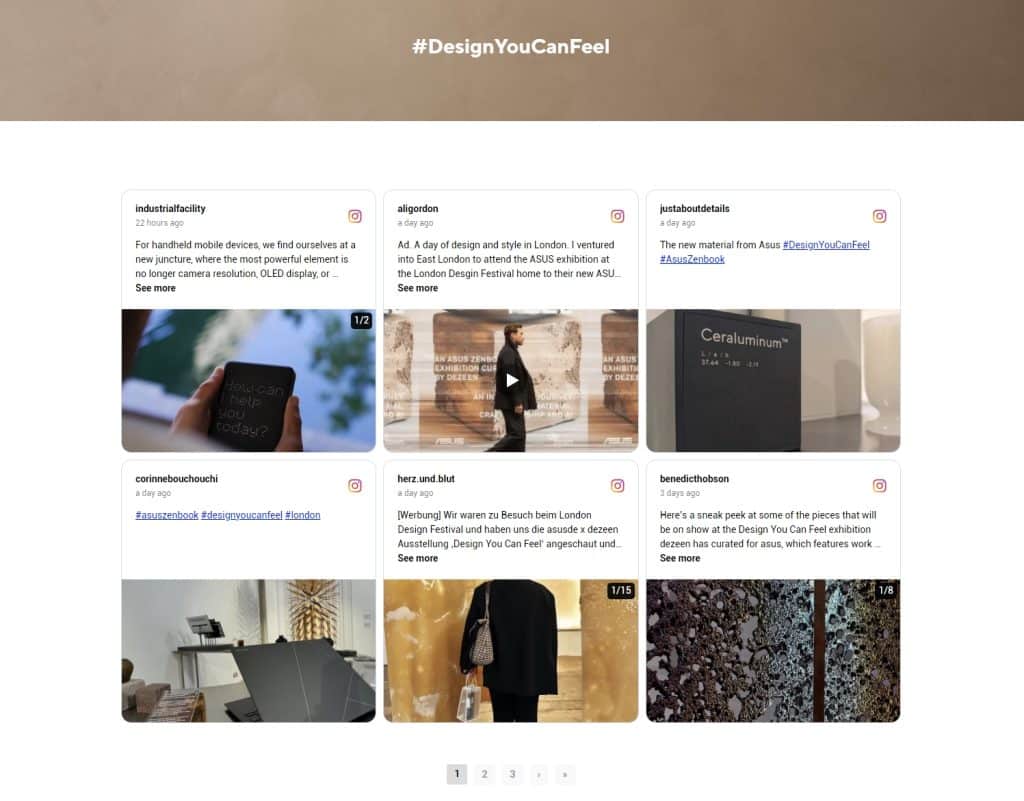
As you can see, the feed layout is perfect for showing off customers’ experiences with the Zenbook, as each card is a full-blown story, especially when you click on it.
Washingborough Hall – #WashyHallMoments
Next up, we have Washingborough Hall—a wonderful hotel in Lincoln, UK—showcasing the experiences their customers and visitors have doing anything from enjoying their afternoon tea or tying the knot during a gorgeous wedding ceremony:
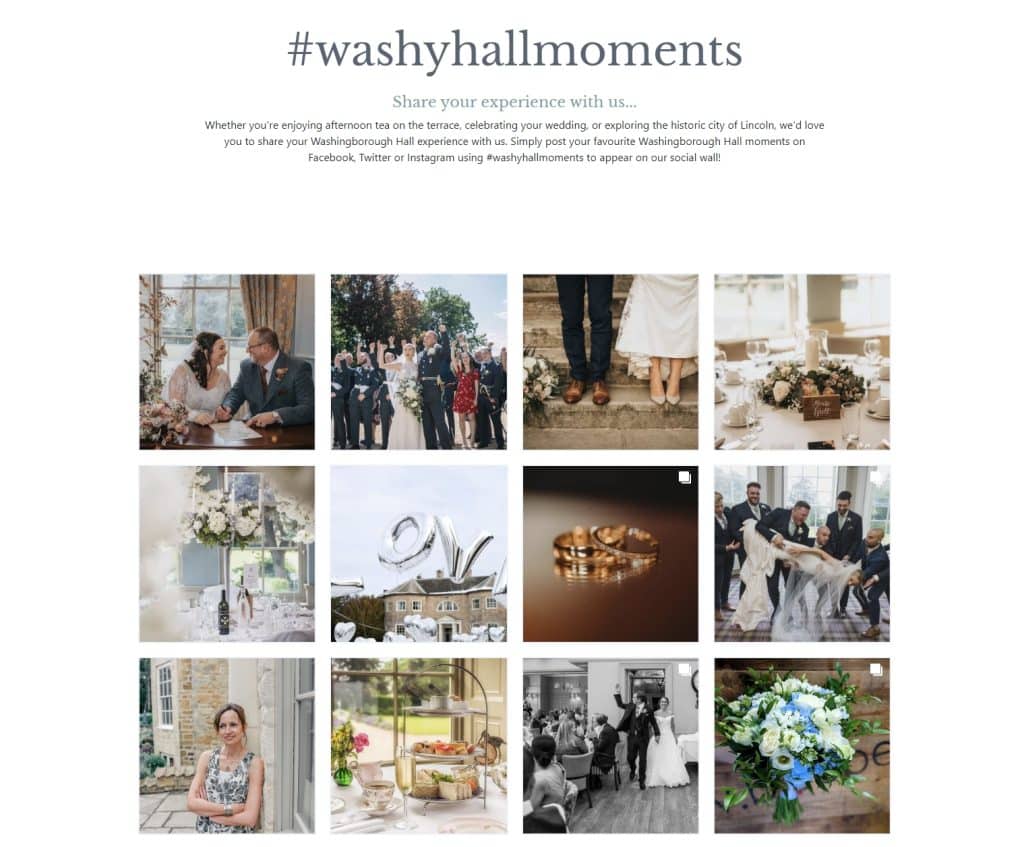
Their users are only prompted to share photos of their experience by using the tag #washyhallmoments, which the hotel later reuses in a captivating UGC widget.
When it comes down to it, UGC in e-commerce is especially effective since customers can view the product in the real world when shopping.
Read more:
How to analyze UGC for insights?
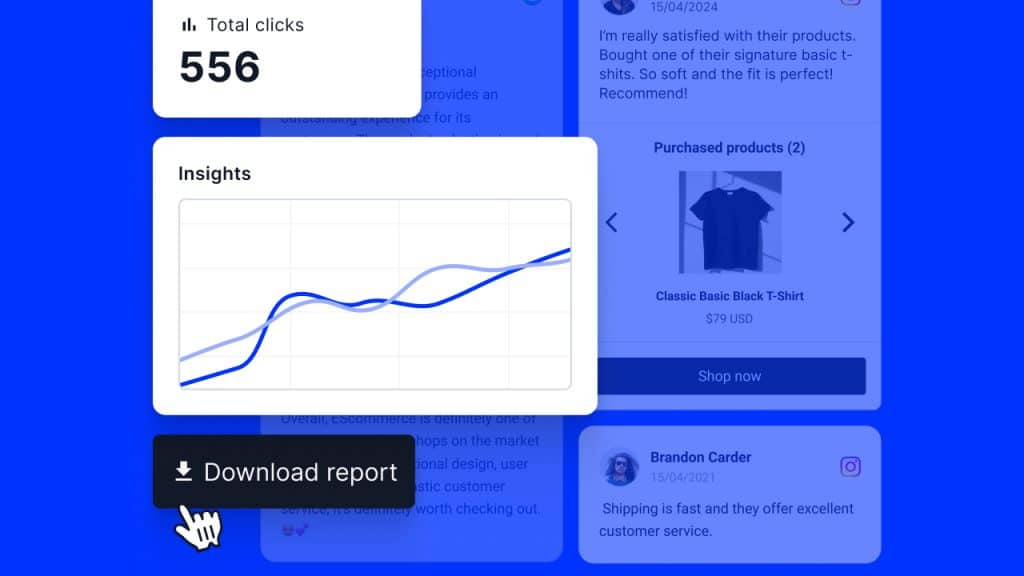
Analyzing user-generated content (UGC) is essential for understanding how it impacts your brand and contributes to your overall marketing goals.
The first step is to measure the effectiveness of UGC via key performance indicators like engagement rates, reach, conversion rates, and sentiment analysis.
By evaluating how often users engage with UGC compared to branded content, you can gauge its influence on customer decisions and brand perception.
However, to effectively analyze UGC, businesses should leverage third-party tools such as Google Analytics or paid UGC providers with analytics and social listening tools. That way, you get insights into metrics like likes, shares, comments, and reach.
Also, you can use AI sentiment analysis tools like EmbedSocial, Brandwatch, or Mention to track the tone around your brand and understand how your audience feels about you.
Last but not least, another powerful method for gathering insights is through A/B testing. For instance, you can compare how UGC performs in an ad campaign versus branded content, measuring which one drives higher engagement or conversions.
At the end of the day, by combining these methods and tools, businesses can gather valuable insights to refine their UGC strategies and maximize their impact.
Common pitfalls to avoid in UGC management
Managing user-generated content comes with its own set of challenges. That said, here are some common pitfalls to avoid and tips on how to overcome them:
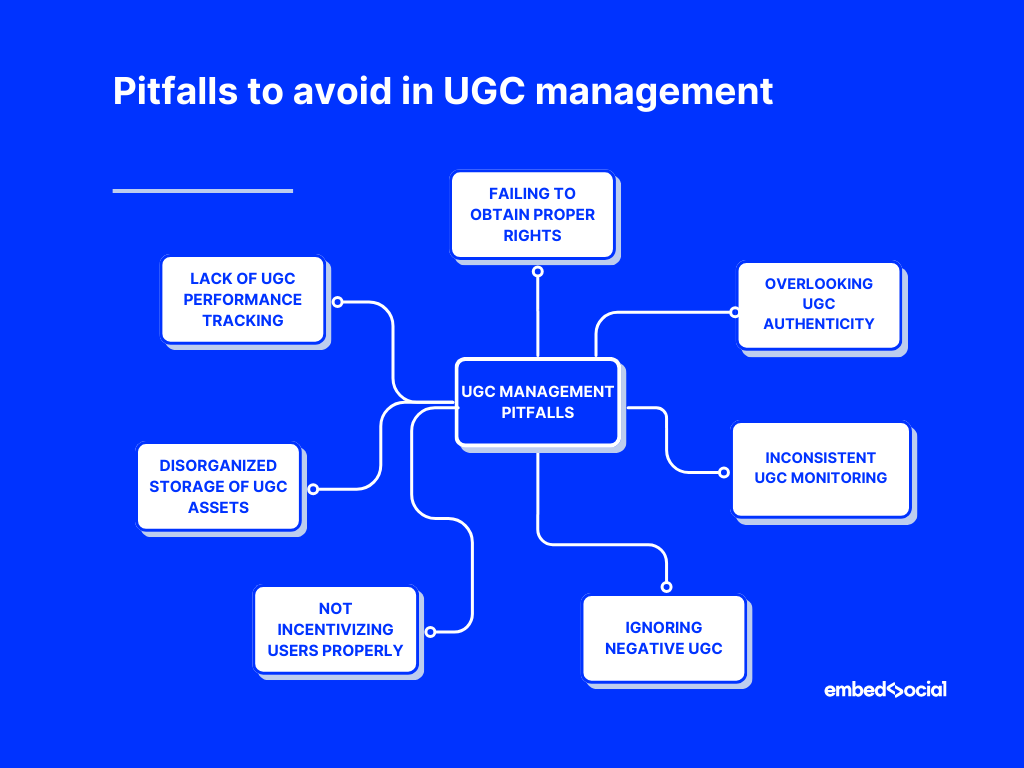
- Failing to obtain proper rights – ensure you have explicit permission from the content creator before using their UGC to avoid legal issues;
- Overlooking UGC authenticity – avoid heavily editing or altering UGC, as this can reduce its authenticity and impact. Stay true to the original content to maintain trust;
- Inconsistent UGC monitoring – regularly track and review UGC submissions to stay on top of content that mentions your brand. Use UGC management tools to streamline this process;
- Ignoring negative UGC – not all UGC will be positive, and avoiding it can harm your brand. Address negative content constructively to show your brand’s responsiveness;
- Not incentivizing users properly – offering minor rewards can result in low participation. Tailor your incentives to your audience’s interests to encourage quality submissions;
- Disorganized storage of UGC assets – storing UGC improperly makes it difficult to find it later. Use centralized storage systems and consistent tagging methods for easy retrieval;
- Lack of UGC performance tracking – analyze your UGC performance to learn what’s working by tracking the effectiveness of your UGC campaigns and making data-driven decisions.
Avoiding these common pitfalls will help you learn how to manage UGC effectively and ensure that it continues to drive value for you and save you marketing funds.
Start leveraging UGC today
By now, every brand manager, marketing executive, business owner, or another interested party has understood that user-generated content is more than a trend.
It has grown to become an essential and very cost-effective method for businesses looking to market themselves and connect authentically with their audience.
However, managing UGC effectively requires a solid UGC strategy that encompasses content collection, incentivizing users, obtaining the proper rights, and organizing your UGC content for easy repurposing when the need (or marketing idea) arises.
Whether you’re repurposing content for marketing or using analytics to refine your strategy, UGC management helps you create a customer-driven brand experience.
So, leverage the UGC best practices shared in this guide to tap into the full potential of your UGC, build a brand identity, enhance engagement, and drive sales. Remember to use the right tools, though, to maximize your UGC impact, such as a complete UGC platform like EmbedSocial.
Ready to take your UGC management to the next level? Start implementing these strategies today and turn your customers into your greatest content creators!
FAQs on UGC management
What is UGC and how does it work?
User-generated content (UGC) refers to any form of content—photos, videos, reviews, or social media posts—created by consumers instead of brands; it harnesses authentic customer experiences and can be shared online to boost brand credibility and customer engagement.
What is user-generated content management?
User-generated content management involves the processes and tools used to collect, store, organize, and repurpose UGC effectively. This management is crucial for maintaining control over your brand’s narrative while maximizing the impact of your UGC.
What is an example of user-generated content?
An example of UGC is a customer sharing a photo of themselves using a product on Instagram, tagging the brand, and adding a personal review. This type of content can be reshared by the brand on their own platforms, adding authenticity to their marketing efforts.
How do I monitor UGC?
Monitoring UGC involves using tools and strategies to track and analyze content created by social media users that mention your brand, which often involves setting up social media alerts, regularly reviewing hashtags, and being active on social media and review platforms.
